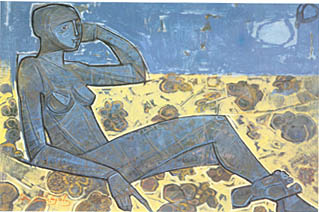
NO LONGER MEMORY BUT DREAM
by Hildreth York
Associate Professor - Rutgers, the State University of New Jersey
Menelaos Katafigiotis trusts his memories and his creativity in the continuing reinvigoration of favored forms and motifs. But memory is never simple, and an artist's memories become art only after they have been distilled into an essence, which is no longer memory but dream. Katafigiotis' dream-like figures balance solemnly within his paintings, carved from their mysterious color-rich environments by their active contours. The figures gaze into the distance of their private spaces, avoiding not only confrontation but individuality and sexuality. Their dignity and self-containment are in constant encounter with Katafigiotis' expressionist energy. Their forms contain the memory of archaic Greek art passed through the mind and hand of one familiar with cubism and surrealism. The planes of color, essentialization of anatomy, and firm technical control reveal an artist who thinks sculpturally yet paints with rich colors and an affinity for decorative surfaces.

Katafigiotis leaves the analysis of his work to the viewer, rightly stating that he is a painter, not a critic. His job is to bring to visibility the forms that are significant to him. Many of his images are inspired by his childhood and youth in Thessaly. They resonate with mythic content. This deeper matrix for Katafigiotis' subject matter obviates the limitations of real time and space. The generic figures, the powerful horses, the reclining females, all re-occur, along with the ubiquitous sun, sometimes brilliant, sometimes shielded by other colors.
Changes are subtle and interesting: Katafigiotis' recent large paintings are looser, with more variety within the figures, more painterly calligraphy and pattern linking figure and background. This writer sees more use of tertiary colors in combination - the melancholy of lavender-gray, the richness of deep blue-green - with patterns of light blues, warm pinks, yellows and oranges floating up to the surface. The axial directions of figures are more varied in single figure and multi-figure compositions. The writer's personal favorite shows the head of a large foreshortened horse in the foreground turning away to the right while a small horse and rider race, perpetually suspended in stopped time near the left edge. In another painting a large seated figure leans back, her face turned strongly to the left, while she holds in the lower right corner a face-jar which looks to the right. A large work depicts a winged horse and satyr flanking a girl; the compositional dynamic implies both physical and mythological struggle as she pulls away from the goat-Iegged creature and toward potential flight.
Katafigiotis acknowledges the symbolic content of his work, but prefers not to define or interpret it. In some cases connections are obvious: The golden straw hat covering the face of a sleeping girl is surrogate for the sun of other paintings; a bird poised on a human head and about to take flight seems aspiring and optimistic. In contrast, the themes and colors of some of the recent paintings suggest a more introspective mood, combined with more adventurous manipulation of the medium of oil paint. Yet, as Katafigiotis wishes, it is his work to make art, and it is for us to respond to the repertoire of images he places before us.
